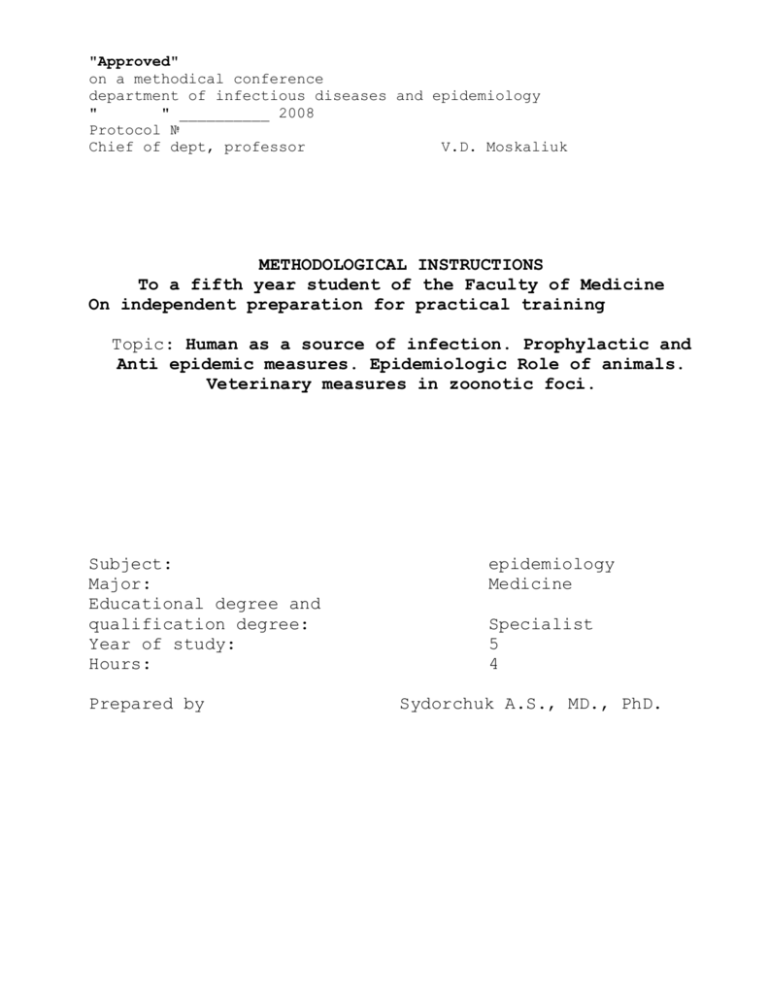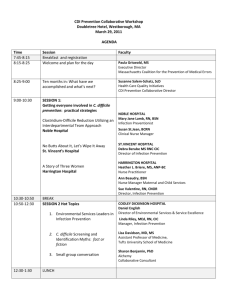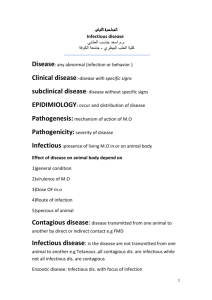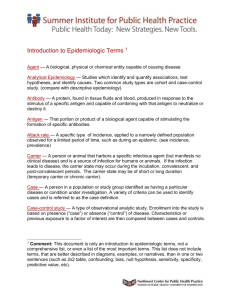"Approved"
advertisement

"Approved" on a methodical conference department of infectious diseases and epidemiology " " __________ 2008 Protocol № Сhief of dept, professor V.D. Moskaliuk METHODOLOGICAL INSTRUCTIONS To a fifth year student of the Faculty of Medicine On independent preparation for practical training Topic: Human as a source of infection. Prophylactic and Anti epidemic measures. Epidemiologic Role of animals. Veterinary measures in zoonotic foci. Subject: Major: Educational degree and qualification degree: Year of study: Hours: Prepared by epidemiology Medicine Specialist 5 4 Sydorchuk A.S., MD., PhD. 1. Topic: Human as a source of infection. Prophylactic and Anti epidemic measures. Epidemiologic Role of animals. Veterinary measures in zoonotic foci. 2. Lesson duration: 4 hours. 3. Aims of the lesson: 3.1. Students are to know: • The source of contagium is the infected (patient, and sometimes healthy) organism of man or animals (at zoonosis). At the sapronosis source of infections can be an environment (1th law of epidemiology). • Localization of contagium can be in the organism of man or animal: on to the mucous membrane of intestine, mucous membrane of respiratory tracts, in blood, on a skin and external mucous membranes (4th law of epidemiology). • Mechanism of transmission of the infectious agent: fecal-oral, air-drop, by blood, contact. • Specific localization of causative agent of infectious diseases in an organism and proper by it mechanism of transmission served a base for classification of infectious diseases: intestinal, bloody, respiratory tracts, external covers (3th law of epidemiology). • Constituents of epidemic process: 1. source of contagium; 2. mechanism of transmission; 3. receptivity of population (4th law of epidemiology). 3.2. Students are to be able: • To collect epidemiology anamnesis for infectious patients. • At intestinal infection to expose the possible source of contagium and factors of transmission: water, food products, hands and articles of environment, flies. • To organize the leadthrough of deratization in the foci of zoonotic infection. • At the infections of external covers to expose the source of contagium and isolation of him from a healthy collective. 3.3. Students are to acquire the following skills: • By the method of collection of epidemiology anamnesis: whether the sick did not communicate with infectious patients, or not patients in family, at home, at work, among those, that used a that meal, whether was not in touch with by patients by animals, presence of wound, operations, blood transfusion and other damages of skin, about the bites of home or wild animals, insects and other • By the method of inspection of epidemic focus: exposure of source of contagium, mechanism of infection and factors of transmission (water, food products, especially milk, articles of the home use, rodents), looking after pin and early exposure of the repeated cases of disease. 4. Advices to the student: • During the leadthrough of inspection of epidemic focus and at collection of epidemiology anamnesis at patient, to remember that every patient is the source of contagium, and that is why it is needed to following to the rules of the personal hygiene. • At questioning of patient and his family members to set questions concrete, which would not humiliate dignity of man, following to the rules of medical ethics. • Able critically to estimate the achievements and failings at the inspection of epidemiology focus. Infectious diseases are classed according to their source as anthroponoses (the source of infection is man), zoonoses (the source of infection is animal), and anthropozoonoses (both man and animal can be the source of infection). An infected macroorganism (man or animal), being the sole source of infection, can have either clinically manifest or asymptomatic form of the disease. A diseased person is the primary source from which the infection spreads. A patient is the most dangerous source of infection because he or she releases a great quantity of the pathogenic microorganisms. The danger of infection spreading from the patient depends on the period of the disease. During the incubation period the role of the patient is not great because the pathogenic microorganism resides inside tissues and is seldom released from the infected organism. The pathogenic agents are released into environment during the late incubation period only in measles, cholera, dysentery, and some other diseases. The greatest quantity of microbes are released during the advanced stage of the disease which is associated with some clinical manifestations of the disease such as frequent stools (dysentery), frequent stools and vomiting cholera), sneezing and cough (airway infections). The danger of infection spreading during the early period of the disease depends on pathogenesis of a particular infectious disease. For example, in typhoid fever or paratyphoid A and B, the patients are not dangerous to the surrounding people during the first week of the disease, while in respiratory infections, the patient is a danger to the surrounding people from the moment when the clinical symptoms of the disease become apparent. Severity of the disease is of great epidemiologic importance for determining "the source of infection". If the disease is severe, the patient remains in bed and can only infect his relatives. But it is difficult to diagnose the disease if it runs a mild course; besides, the patient often does not attend for medical aid and continues performing his routine duties (at the office, school, and the like) thus actively promoting the spread of infection. Carrier of infection is another source of morbidity. According to modern views, carrier state is an infectious process that runs an asymptomatic course. But those who sustained an infectious disease, tularaemia, plague, leptospirosis, rickettsiosis, encephalitis, leishmaniasis and some other diseases. Main and secondary sources of infection are distinguished in zoonosis. The main source are animals which are a harbour of pathogenic microorganisms and they create natural nidi of tularaemia, plague, and other diseases. Secondary sources of infection become involved periodically in epizootic. Humans can be infected by wild animals when hunting, during stay in wild environment contaminated with excrements, when drinking water or eating food that may be contaminated with excrements of wild animals. Birds can also be transmitters of infection (ornitosis, salmonellosis, etc.). Mechanism of transmission. For the epidemic to break out it is not sufficient to have a source of infection alone. The causative agent can survive only if it is transmitted from one host to another, because any given macroorganism destroys the pathogenic microorganisms by specific antibodies that are formed in it in response to the ingress of these microorganisms. Death of an individual host terminates the life of the parasitizing microorganisms. The only exception are spore-forming microbes (causative agents of anthrax, tetanus, botulism). The combination of routes by which the pathogenic microorganisms are transmitted from an infected macroorganism to a healthy one is called the mechanism of infection transmission. Four mechanisms of infection transmission are distinguished according to the primary localization of pathogenic agents in macroorganisms: (1) faecal-oral (intestinal localization); (2) air-borne (airways localization); (3) transmissive (localization in the blood circulating system); (4) contact (transmission of infection through direct contact with another person or environmental objects). Three phases are distinguished in the transmission of infection from one macroorganism to another: (1) excretion from an infected macroorganism; (2) presence in the environment; (3) ingress into a healthy macroorganism. The method by which microbes are excreted from an infected macroorganism (the first phase) depends on the locus of infection in the infected individual or a carrier. If pathogenic microorganisms reside on respiratory mucosa (influenza, measles, pertussis) they can be released from the patient only with expired air or with droplets of nasopharyngeal mucus. If the infection is localized in the intestine, the pathogenic microorganisms can be excreted with faeces (dysentery). The pathogenic organisms in the blood infect blood-sucking arthropods. 5. Control questions: 1. Epidemiology role of sick man in different periods of illness. 2. Name infectious diseases, at which the source of infection are home and wild animals, rodents, birds. 3. Name localization of contagium in the organism of sick man, bacillicarrier and sick animal. 4. Mechanism of transmission of infectious agent from an organism, stay of him in an environment and penetration of him in a new organism. 5. Describe the mechanism of infection at infectious diseases, localization of contagium, classification of infectious diseases. 5. What is epidemic process? 6. Name the laws of epidemiology, formulated by Gromashevsky. 7.What does value for a doctor to have collection of epidemiology anamnesis? 6. Literature: 6.1. Basic: 1. Lecture 2.Epidemiology and Fundamentals of Infectious Diseases. M.L. Volovskaya. Mir Publisher. Moscow.






